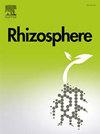Optimizing the scale of spatial aggregation in minirhizotron studies of crop root system distribution
IF 3.5
3区 生物学
Q1 PLANT SCIENCES
引用次数: 0
Abstract
Research into root system distribution often employs analyses in which depth is treated as a categorical variable. It is not presently known to what extent the choice of strata size affects type I and type II error rates in such analyses, or how to maximize statistical power while controlling for false positives. This research addresses those questions using a simulation study: mixed models were fit to each of one thousand simulated data sets, for 400 treatment combinations associated with differing levels of spatial and temporal autocorrelation, different effect sizes, and different degrees of spatial aggregation. The results show that statistical power declined with increasing degrees of aggregation, especially for small effect sizes and in the presence of spatial autocorrelation. Specifically, in the absence of spatial autocorrelation and with a true effect size of 6, aggregating 80 data points into 4, 20 cm depth class reduced statistical power from a very high initial rate of 0.946 (95% Confidence Interval: 0.935–0.955) to the still acceptable rate of 0.855 (0.839–0.870), but for an effect size of just one, initial power was already lower, at 0.656 (0.635–0.677) when no aggregation was performed and fell to just 0.373 (0.352–0.395) upon aggregating to 20 cm depth classes. This pattern is even more pronounced in the presence of spatial autocorrelation. Overall, the study recommends that researchers choosing to employ such an analysis for their minirhizotron data use the smallest computationally feasible depth classes.
优化作物根系分布的空间聚集尺度
对根系分布的研究通常采用深度作为分类变量的分析方法。目前尚不清楚地层尺寸的选择在多大程度上影响此类分析中的I型和II型错误率,也不知道如何在控制误报的同时最大化统计能力。本研究通过模拟研究解决了这些问题:混合模型适用于1000个模拟数据集中的每一个,适用于400种处理组合,这些组合具有不同程度的时空自相关、不同的效应大小和不同程度的空间聚集。结果表明,统计能力随着聚集程度的增加而下降,特别是在效应大小较小和存在空间自相关的情况下。具体来说,在没有空间自相关且真实效应大小为6的情况下,将80个数据点聚集到4,20 cm深度类别中,从0.946的非常高的初始率(95%置信区间:0.935-0.955)到仍然可以接受的0.855(0.839-0.870)的比率,但对于效应大小只有1,初始功率已经较低,在不进行聚合时为0.656(0.635-0.677),在聚合到20 cm深度分类时降至0.373(0.352-0.395)。在存在空间自相关的情况下,这种模式更加明显。总的来说,该研究建议研究人员选择使用最小的计算可行深度类来对他们的minihizotron数据进行这样的分析。
本文章由计算机程序翻译,如有差异,请以英文原文为准。
求助全文
约1分钟内获得全文
求助全文
来源期刊

Rhizosphere
Agricultural and Biological Sciences-Agronomy and Crop Science
CiteScore
5.70
自引率
8.10%
发文量
155
审稿时长
29 days
期刊介绍:
Rhizosphere aims to advance the frontier of our understanding of plant-soil interactions. Rhizosphere is a multidisciplinary journal that publishes research on the interactions between plant roots, soil organisms, nutrients, and water. Except carbon fixation by photosynthesis, plants obtain all other elements primarily from soil through roots.
We are beginning to understand how communications at the rhizosphere, with soil organisms and other plant species, affect root exudates and nutrient uptake. This rapidly evolving subject utilizes molecular biology and genomic tools, food web or community structure manipulations, high performance liquid chromatography, isotopic analysis, diverse spectroscopic analytics, tomography and other microscopy, complex statistical and modeling tools.
 求助内容:
求助内容: 应助结果提醒方式:
应助结果提醒方式:


